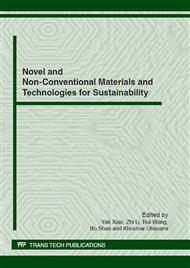[1]
Ghavami, K. Cement Composites Reinforced with Bamboo and Vegetable Fibers. Proc. of the First International Conference on Concrete & Development, Tehran / I. R. Iran, Apr. 30-May 2, v. II, 2001, pp.445-461.
Google Scholar
[2]
Brasil. Ministério da Ciência e Tecnologia Livro Verde – O debate necessário: Ciência, Tecnologia, Inovação – Desafios para a Sociedade Brasileira. Brasília: MCT/Academia Brasileira de Ciências, jul. (2001).
DOI: 10.29327/cb-ciencias-exatas-computacao-tecnologia-inovacao-1.598936
Google Scholar
[3]
Morin, J.; Rafferty, P. J. The six key functions of technological resources management. Miami/Florida-USA: Institute of Industrial Engineering. Proc. of the Second International Conference on Management of Technology, Feb. 28–Mar. 2, 1990, pp.621-627.
Google Scholar
[4]
Marcovitch, J.; Ohayon, P. Évaluation em Science et Technologie au Brésil. Paris: CPE/MRT. Colloque international CPE – Méthodologies évaluatives de la recherche. CPE Étude, n. 51, pp.63-79, Mai (1985).
Google Scholar
[5]
Valeriano, D. L. Gerência em Projetos – Pesquisa, Desenvolvimento e Engenharia. São Paulo: Makron Books, (1998).
Google Scholar
[6]
Quinn, J. B. The measurement and evaluation of research results. Hanover, New Hampshire: Darthmouth College, (1958).
Google Scholar
[7]
Asbury, W. C. Establishing research projects. In: Heyel, C. (ed. ) Handbook of industrial research management. 2. ed. New York: Reinhold Book, (1968).
Google Scholar
[8]
Cleland, D. I. Systems analysis and project management. 2. ed. New York: McGraw-Hill, 1975. (series in Management).
Google Scholar
[9]
O'Brien, P. E.; James, J. Project management – an overview. Project Management, Lancaster/Pa, v. 8, n. 3, pp.27-32, Sept. (1977).
Google Scholar
[10]
Decotiis, T. A.; Dyer, L. Defining and measuring project performance. Research Management, Lancaster/Pa, v. 22, n. 1, pp.17-22, Jan. (1979).
DOI: 10.1080/00345334.1979.11756516
Google Scholar
[11]
Vasconcellos, E. P. G. de. Avaliação do desempenho de projetos de pesquisa tecnologia. In: V Simpósio de Pesquisa em Administração de Ciência e Tecnologia. 1980, São Paulo. Anais. São Paulo: IA/USP.
DOI: 10.29327/155543.1-8
Google Scholar
[12]
Ellis, l. Introduction to Evaluating R&D Process Management. Evaluation of R&D Processes: Effectiveness Through Measurements. Norwood/MA: Artech House, (1997).
Google Scholar
[13]
Geisler, E. The Metrics of Science and Technology. Westport/CT: Quorum Books, (2000).
Google Scholar
[14]
Cleland, D. I.; Ireland, L. R. O Gerenciamento de Projetos. 2. ed. Gerenciamento de Projetos. Rio de Janeiro: LTC, 2007. (Capítulo 1).
DOI: 10.11606/d.103.2021.tde-22032023-081906
Google Scholar
[15]
Clifford, F. G.; Larson, E. W. Gerenciamento de projetos moderno. Gerenciamento de projetos – o processo gerencial. 4a. ed. São Paulo: McGraw-Hill, 2009. (Capítulo 1).
Google Scholar
[16]
The World Bank Building Evaluation Capacity. Washington: The World Bank / Operations Evaluation Department. Lessons & Practices, n. 4, pp.1-11, (1994).
Google Scholar
[17]
International Atomic Energy Agency Planning and Designing IAEA Technical Co-Operation Projects: Guidelines. Vienna/Austria: IAEA, Department of Technical Co-Operation. Jun. (1997).
Google Scholar
[18]
Knowlton, L. W.; Phillips, C. C. The Logic Model Guidebook – Better Strategies for Great Results. Thousand Oaks/Ca: Sage, (2009).
DOI: 10.3138/cjpe.27.006
Google Scholar
[19]
Cunningham, P.; Nedeva, M. Towards a system of continuous evaluation and monitoring for European co-operation in scientific and technical research (COST). Research Evaluation, v. 8, n. 3, pp.142-154, Dec. (1999).
DOI: 10.3152/147154499781777487
Google Scholar
[20]
Brasil. Ministério do Meio Ambiente Relatório sobre a Aplicação Preliminar dos Indicadores do Projeto AMA para Monitoramento do PPG7. Brasília: MMA/ Secretaria de Coordenação da Amazônia. Projeto Piloto para Proteção das Florestas Tropicais do Brasil – PPG7. Projeto Apoio ao Monitoramento e Análise – AMA. Mar. (2001).
DOI: 10.1590/s1414-753x2010000200006
Google Scholar
[21]
UNEP Bergen Ministerial Declaration of Sustainable Development in the ECE Region. Bergen/Norway, 14-15 May, 1990, Industry and environment, v. 13, n. 2, pp.54-56, Apr. /Jun. (1990).
Google Scholar
[22]
Mullick, A. K. Role of Cement and Concrete in Sustainable Societal Development. 1st International Conference on Concrete & Development, Tehran/Iran, Apr. 30–May 2, 2001, pp.573-582.
Google Scholar


